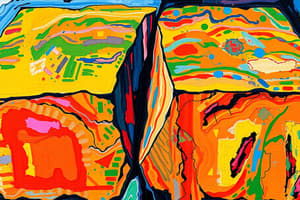Podcast
Questions and Answers
What type of motion drives transform fault boundaries?
What type of motion drives transform fault boundaries?
- Radial expansion
- Lateral shearing forces (correct)
- Lateral tension forces
- Vertical compression
Which of the following features is typically absent in transform fault boundaries?
Which of the following features is typically absent in transform fault boundaries?
- Fault lines
- Shearing forces
- Earthquake activity
- Crust creation or destruction (correct)
What characterizes a transform fault boundary?
What characterizes a transform fault boundary?
- Tectonic plates move apart from each other
- Tectonic plates are created at this boundary
- Tectonic plates collide forcefully
- Tectonic plates slide horizontally past one another (correct)
Which fault is an example of a continental transform fault?
Which fault is an example of a continental transform fault?
How do ridge-ridge transform faults occur?
How do ridge-ridge transform faults occur?
Which term describes a location where three tectonic plates meet?
Which term describes a location where three tectonic plates meet?
What is the primary geological activity associated with transform boundaries?
What is the primary geological activity associated with transform boundaries?
What connects a mid-ocean ridge to a subduction zone?
What connects a mid-ocean ridge to a subduction zone?
Which feature marks the transition between offset segments of a mid-ocean ridge?
Which feature marks the transition between offset segments of a mid-ocean ridge?
What is a unique characteristic of transform boundaries compared to other plate boundaries?
What is a unique characteristic of transform boundaries compared to other plate boundaries?
Flashcards are hidden until you start studying
Study Notes
Transform Fault Boundary
- Two tectonic plates slide horizontally past one another
- Also known as a conservative boundary as no crust is created or destroyed
- Driven by lateral shearing forces
- Generally vertical, running parallel to plate motion
- Little to no volcanic activity
- Known for earthquakes due to stress build-up along fault lines
Types of Transform Boundaries
- Oceanic Transform Faults:
- Associated with mid-ocean ridges
- Create fracture zones, linear features that mark the transition between offset segments of a mid-ocean ridge
- Continental Transform Faults:
- Found on land
- Create long fault lines, example: San Andreas Fault
Ridge-Ridge Transform Fault
- Breaks or offsets that occur along the intersection of two mid-ocean ridges
- Happen due to variations in the spreading rates of tectonic plates
- One side of a mid-ocean ridge spreading faster than the other can create a kink or offset where the two ridges meet
Ridge-Trench Transform Fault
- Connects a mid-ocean ridge (plates moving apart) to a subduction zone (one plate sliding beneath another)
- Acts as a transition zone between these two different types of plate boundaries
Triple Junction
- Where three tectonic plates meet
- At least one transform fault is present
Studying That Suits You
Use AI to generate personalized quizzes and flashcards to suit your learning preferences.




